Taiseki-ji
Tahō Fuji Dainichirenge-zan Taiseki-ji (多宝富士大日蓮華山大石寺); more commonly just Sōhonzan Taiseki-ji (総本山大石寺), informally known as Head Temple Taiseki-ji (大石寺) is the administrative center of Nichiren Shoshu Buddhism. It is located in the foothills of Mount Fuji in Kamijo, Fujinomiya, Shizuoka Prefecture, Japan.[1][2][3] Taiseki-ji was founded in 1290 by Nikkō Shōnin, one of Nichiren's immediate disciples, on a land parcel donated by the believer Daigyo Sonrei, commonly known as Nanjo Tokimitsu.[4] [5]
| Head Temple Taiseki-ji | |
|---|---|
多 宝 富 士 大 日 蓮 華 山 大 石 寺 | |
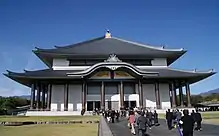 The Hōandō | |
| Religion | |
| Affiliation | Buddhism |
| Sect | Nichiren Shōshū |
| Deity | The "Dai Gohonzon of the High Sanctuary of the Essential Teachings" |
| Location | |
| Location | Foot of Mount Fuji in Fujinomiya, Shizuoka prefecture |
| Country | Japan |
| Geographic coordinates | 35°16′56″N 138°35′09″E |
| Architecture | |
| Founder | Nikkō Shonin |
| Groundbreaking | 1290 |
| Website | |
| http://www.nichirenshoshu.or.jp/ | |
The temple is the home of the Dai Gohonzon, Nichiren Shoshu's object of worship, which draws pilgrim believers from various countries. The temple's vast open grounds are also open to the public for sightseeing, though its religious buildings are restricted to non-believers.[6][7] Accordingly, adherents of the Soka Gakkai are not permitted entry to the Head Temple buildings.[8]
Description
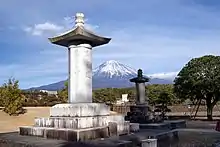
Taiseki-ji is Nichiren Shoshu's administrative center, and its chief abbot (貫主, Kan-Cho) Chief Priest is simultaneously the high priest (法主 (Ho-Su)) of Nichiren Shoshu. The current 68th High Priest is Nichinyo Hayase (1935 – Present) who assumed the position on 16 December 2005.[9]
Taiseki-ji is the home of the Dai Gohonzon, Nichiren Shoshu's object of worship.[10] [11] This image is visited by believers who come on personal pilgrimages, to participate in regular ceremonies, or to take part in large events such as study programs, and similar large meetings.[12] The temple is known for numerous historically significant buildings and gardens, national cultural assets, as well as features like the old weeping cherry trees that line its Tatchū (main path lined with lodging temples).[13][14]
History
According to Nichiren Shoshu tradition, Taiseki-ji was founded in 1290 by Nichiren's disciple Nikkō on a tract of land called Ōishigahara (大石ケ原 "great stone meadow") donated by the district steward, Nanjo Shichiro Jiro Hyoe Taira no Tokimitsu (Buddhist name: Daigyo Sonrei) (1259–1332). The name derives from an alternative reading of the kanji for Ōishi (大石), Tai (Big) - Seki (Stone), and the character Ji (寺), temple. Tokimitsu was one of Nichiren's lay followers and he looked up to Nikkō as his personal teacher. Taiseki-ji started with one small temple building, the Mutsubo with six rooms, but grew gradually as Nikkō's disciples built sub-temples. It went through further growth phases during the mid-Edo and in the post-World War II periods.
According to Nichiren Shoshu doctrine, Nichiren Daishonin willed that the Dai-Gohonzon of the High Sanctuary of the Essential Teachings to be established at the foot of Mt. Fuji when worldwide propagation was achieved.
Pilgrimage
Pilgrimage to Taiseki-ji Head Temple, draws adherents of Nichiren Shoshu from all over the world annually through group trips, planned by local branch temples, and individual trips. Pilgrimage, within Nichiren Shoshu, to the Head Temple Taiseki-ji at the base of Mt. Fuji is called, Tozan, literally meaning "to climb the mountain. Practitioners make Tozan with the purpose of going to worship the Dai-Gohonzon.[15][16] Nichiren Shoshu has encouraged pilgrimage to Taiseki-ji since its establishment.[17][18] Making Tozan is considered a core aspect of the practice of Nichiren Buddhism within the Nichiren Shoshu sect. Nichikan Shonin, the twenty-sixth High Priest of Nichiren Shoshu, described the sect’s teaching on the benefits of visiting the Dai-Gohonzon, enshrined at Taiseki-ji, as follows:
”This Gohonzon bestows limitless, infinite benefit, and Its unfathomable workings are vastly profound. Therefore, if you chant Nam-Myoho-Renge-Kyo with faith in this Gohonzon for even a short while, there is no prayer that will not be answered, no evil that will not be eradicated, no blessing that will not be bestowed, and no reason that will not become clear.”
— Nichikan Shonin Mondan [19]
This doctrine is taught when encouraging Nichiren Shoshu adherents to make a pilgrimage to Taiseki-ji. The introductory book, Nichiren Shoshu Basics of Practice states in summary of this teaching:
“Therefore, at any possible opportunity we should make a pilgrimage to the Head Temple, where the Dai-Gohonzon is enshrined.”
— Nichiren Shoshu Basics of Practice[20]
Gokaihi
Gokaihi (Audience with the Dai-Gohonzon), is a Nichiren Shoshu ceremony, officiated by the High Priest or his designated surrogate, in which believers are permitted to enter the Hoando Enshrinement Hall and worship the Dai-Gohonzon directly.[21][22]
The sect describes the development of the Gokaihi ceremony as follows:
In the course of the more than 750-year history of Nichiren Shoshu, there has been a gradual increase in the number of believers who have had the occasion to hear about the great benefit and magnificent power of the Dai-Gohonzon, and they have developed a strong yearning to see it. The successive High Priests have felt great compassion due to the faith of these pure-minded believers and have allowed them to come into the sanctum housing the Dai-Gohonzon in order to worship the Dai-Gohonzon at close range.
— Nichiren Shoshu Basics of Practice[23]
Attending this ceremony is the primary reason that believers make a pilgrimage to Taiseki-ji as the Gokaihi is the only opportunity to worship the Dai-Gohonzon directly.[24]}}
List of buildings
The following significant buildings are listed for their historical and architectural value:
Sanmon Gate
.jpg.webp)
The Sanmon (written 三 門, sometimes 山 門) gate is Taiseki-ji's "front door" and has been designated as a Shizuoka prefectural cultural asset. It was built in 1717 with financial assistance from Lady Tennei-in, the wife of sixth Shōgun Tokugawa Ienobu, who donated 300 ryō for its construction. In 1997, it was significantly vandalized and defaced with graffiti. It was recently restored and is awaiting public presentation.
Mutsubō
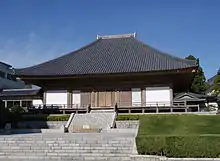
The first Mutsubō (六 壷) was erected in 1290 as Taiseki-ji's first building. It has been rebuilt many times since, but the Gohonzon (object of veneration) it houses is attributed to temple founder Nikkō Shōnin dating from November 1332. It maintains its original design of having six rooms.[25] The current structure, which uses much keyaki heartwood, was completed in 1988. The High Priest of Nichiren Shoshu proceeds to the Mutsubō on concluding Ushitora Gongyo in the Kyakuden (see below) to perform another gongyo recitation with young priests and acolytes.
Kyakuden
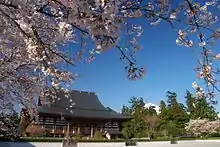
The Kyakuden (客殿 "Reception Hall") is one of the central structures where the majority of ceremonies are held, including Ushitora Gongyo by each successive High Priest every morning. It was built in 1465 and later rebuilt in 1998.[26]
The Kyakuden was rebuilt as the Dai-Kyakuden (大客殿 "Grand Reception Hall"), with the assistance of the Soka Gakkai, a modern-style building inaugurated April 1964.[27] That structure, was demolished in September 1995 and rebuilt as the current Kyakuden in 1998 with its wood-clad steel-framed edifice. The priesthood cited the Dai-Kyakuden's imposing ferroconcrete mass as incongruent with the architectural tone appropriate for a temple compound.
The Kyakuden, Reception Hall, is the site of Ushitora Gongyo, a daylight prayer service officiated by the High Priest or his proxy. The Ozagawari Joza Gohonzon ("Gohonzon of the Seat of the Dharma") is enshrined in the hall on the second floor of the Kyakuden, flanked by lifesize statues of Nichiren Daishonin (left) and Nikkō Shōnin (right).
Mieidō
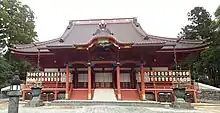
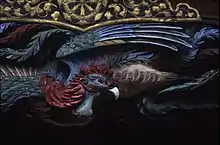
The Mieido (English: Image Hall Kanji: 御 影 堂) traces its history to a building called the Mido (Midō: 御堂) erected by Nikko Shonin when he founded Taisekiji in 1290. It takes its name from a lifesize image of Nichiren sculpted by Japanese Buddhist artisan Echizen Hōkyō Kaikei, a carver of Buddhist images. This image was enshrined in the year 1388 in a building that was then replaced in 1522. The current, classical structure was erected in 1632 with donations from Kyōdai-in, wife of Hachisuka Yoshishige, Lord of the Tokushima Castle. Several rounds of expansions, improvements, and repairs have been undertaken since then, and it was designated a prefectural tangible cultural property by Shizuoka Prefecture after major repairs in 1971. The most recent overhaul was finished in November 2013. The seven-year project entailed completely breaking down and reassembling the building piece by piece. All the parts were cataloged, mapped, and their condition recorded. Damaged structural members were repaired or replaced, and decorative fixtures such as transom carvings and other artwork, were painstaking restored. When the building was reassembled, aseismic structural augmentation (dampers) was installed to protect it from earthquake damage. New gold leaf was applied to the indoor pillars, and all exposed surfaces were finished with vermilion using traditional methods.[28][29][30] The building is known for its decorative transoms that depict various Buddhist deities that are believed to occupy the Treasure Tower of the Lotus Sutra.
Hōandō
The Hōandō (奉安堂) Enshrinement Hall, built in 2002, houses the Dai Gohonzon of the High Sanctuary of the Essential Teaching, the supreme object of worship in Nichiren Shōshū.[31][32] The Hōandō is built in the style of a Kura storehouse to signify that the Nichiren Shoshu faith has not yet taken hold as the primary religion of the world's people. Nichiren Shoshu claims that Nichiren willed that the Dai Gohonzon is not to be made publicly accessible, but rather stored away and only viewed by those who have asked for and been granted an audience by the High Priest, until such time. Another interpretation of this is that, as different from all other Nichiren Shoshu altars, the one in the Hōandō has neither offerings of evergreens nor drums, and non-believers are not permitted entry. Handicapped believers and their attendants are given priority entry and seating within the building.
On the high altar, the Shumidan, of the Hōandō is a Buddhist Stupa containing the ashes of Nichiren Daishonin (left), an inner-altar housing the Dai Gohonzon (center), and another stupa containing a statue of Nichiren Daishonin carved by Izumi Ajari Nippō Shōnin from the same camphorwood plank that the Dai Gohonzon was inscribed on; while pious tradition claims that Nichiren approvingly characterized the statue as an exact image of himself.

Taiseki-ji has traditionally regarded the Mieidō (see above) as the temple's Hondō (main hall), but only its provisional main hall until wide propagation is achieved, when the building housing the Dai Gohonzon would take over that role.
The Hōandō replaced the Shōhondō (正本堂: true main hall), after its demolition. (See below for details on demolished buildings)
Gohōzō and Hōanden
The Gohōzō (御 宝 蔵) ("Treasure House") houses various religious scrolls and paintings, and other religious and historical records, relics, and artifacts. It possesses the original Gosho documents of Nichiren conversing with the Buddhist deity Hachiman, as well as a personal letter given to Lord Nanjo Tokimitsu while he was alive. In addition, all Gohonzons transcribed by Nichiren Shoshu priests are stored within this building, which are mostly taken out in April for the Omushibarai Ceremony.
In addition, it also features modest displays of cultural objects donated by pilgrims from countries where they have attracted converts. The Hōanden (奉 安 殿) building, where the Dai Gohonzon was once enshrined, stands behind it.
Pagoda
_of_Taiseki-ji.jpg.webp)
Completed in 1749 with the assistance of the Edo government, Taiseki-ji's pagoda was built with donations of 5,000 gold ryō. It is five-storied and faces west rather than the usual south to signify that Nichiren's Buddhism would spread from the east (Japan) to the west; that is, back to the land of Sakyamuni Buddha and beyond to the rest of the world. It is the largest five-storied pagoda along the Tōkaidō, the historical main highway along Japan's eastern seaboard from Edo (today's Tokyo) to Kyoto. The pagoda was designated a national cultural treasure in year 1966 and a major restoration was completed in January 2017. Its doors are ceremoniously opened every February 16 to celebrate Nichiren's birthday.
Graves of early Soka Gakkai Presidents
- On the left rear of the Pagoda is the 1945 grave and Stupa of the first Soka Gakkai President Tsunesaburo Makiguchi.
- The second Soka Gakkai president Josei Toda is located at the left front of the pagoda. His ashes were moved from Jozai-ji temple (Toshima, Tokyo), and reinterred here in 2001.
Daikōdō
The Daikōdō ("English: Grand Auditorium") was donated by Soka Gakkai, with construction completed on 1 March 1958. It houses the “Abutsubo Gohonzon” (often wrongly mistaken for the "Mannenkugo Gohonzon" or "Dai-Honzon" ) inscribed by Nichiren for the enlightenment of women and bestowed to Sennichi, the pious wife of disciple Abutsubo. It is flanked by the ihai memorial tablets of second High Priest Nikkō Shonin and his successor, third High Priest Nichimoku. It is in a dilapidated condition and scheduled for demolition and reconstruction after completion of the new Sanmon gate in 2021.
The former highest lay leader of Hokkeko believers (Hokkeko Sokoto), Jōsei Toda addressed youth adherents from this building on 16 March 1958.
Demolished buildings
Shōhondō
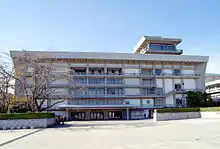
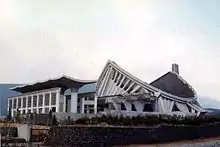
The Shōhondō (正 本 堂 True Main Hall) was a building at Taiseki-ji, which opened in October 1972[33] and was subsequently demolished in 1998. Daisaku Ikeda, who emphasized the building of monuments to the success of the movement,[34] made the request to build the new structure which became the Shohondo.[35] As explained by professor Daniel A. Métraux, the Soka Gakkai placed particular importance on the building of the Shohondo, based on interpretations of doctrine not shared by the Nichiren Shoshu sect as a whole, and therefore controversy over its status arose at its construction.[36]
The Shohondo was inaugurated by the Soka Gakkai who claimed it as the "True High Sanctuary", Kaidan, which was a title disputed by conservative groups within the sect including the Myoshinko (now known as Kenshōkai) lay organisation, and the Nichiren Shoshu Priesthood.[37] [38] In Nichiren Shoshu doctrine that title was reserved for a future temple to be built at the base of Mt. Fuji on the completion of Kosen Rufu, when the Japanese nation would convert to Nichiren’s Buddhism.[39] Professor Métraux explains that the Soka Gakkai was reinterpreting doctrine and maintained that they could consider the Shohondo as the "True High Sanctuary", Kaidan, about which Nichiren wrote, because through the Soka Gakkai Nichiren’s philosophy was spread through Japan and was positively impacting people.[40] The importance of the Shohondo was, therefore, a highly contentious matter dividing the Soka Gakkai and other factions within the faith. [41]
High Priest Nittatsu Hosoi, clarified that the Shōhondō was not the True High Sanctuary about which Nichiren wrote, though directed the Shōhondō as a temporary home for the Dai-Gohonzon, the permanent home of the Dai-Gohonzon would be the future True High Sanctuary.[42]
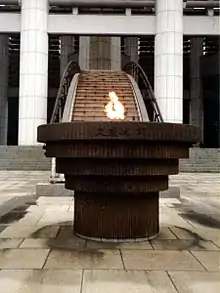
The construction of the Shōhondō was funded largely by donations from lay believers of Nichiren Shoshu. In 1968, approximately 8 million Soka Gakkai adherents contributed money to the construction.[43] An estimated grand total of ¥35,536,000,000 was raised:
- ¥ 35,064,300,000.00 came from the Sōka Gakkai lay organization.
- ¥ 313,820,000.00 from the Hokkekō lay organization
- ¥ 157,870,000.00 from Nichiren Shoshu priests and their families.[44]
The building was demolished in 1998, the official reason given by Nichiren Shoshu for the demolition was the discovery of rust on the pillars within the temple. Engineers discovered that ocean sand had been used in the mortar of the building, risking the Dai Gohonzon's safety during an earthquake. The school also concedes that its demolition of the Shōhondō was an extension of the doctrinal dispute between it and Sōka Gakkai, emphasizing the impiety of the organisation for deviating from its formal doctrines of orthodoxy.[45]
American architects Richard Meier and Robert Arthur Stern both disparaged the demolition. Terence Riley, former chief curator of architecture and design at the Museum of Modern Art in New York opined that the planned demolition would be a "regrettable finale" to a century that has "witnessed so much loss".[46]
Nearby buildings
Myoren-ji Temple
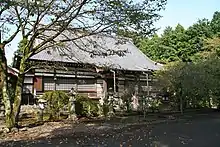
An approximate thirty-minute walk from the Head Temple is Myoren-ji, which is another former residence of Nanjo Tokimitsu, the person who donated the land of Taisekiji to Nikko Shonin. The temple's name derives from the Buddhist name (kaimyō) Nanjo Tokimitsu's wife, Myōren, whose historical birth name is unknown. This temple houses many historically significant artifacts, in particular, the Gohonzon enshrined in its main altar, which was inscribed by Nikko Shonin in the year 1315, and a small, decorative statue of Nichiren that is preserved as a historical remembrance. The temple is known for the unique format of its Oeshiki ceremony commemorating the death of Nichiren.
References
- Nichiren Shōshū Nyūmon (日蓮正宗入門: "Introduction to Nichiren Shoshu"), Taiseki-ji, 2002, pp. 336–348. (Japanese)
- Taisekiji (大石寺), Seikyo Shimbun-sha, 1971 (Japanese)
Notes
- Nichiren Shoshu Temple. “Taisekiji” Nichiren Shoshu Basics of Practice, NST, 2003, pp. 127–128.
- "Taisekiji Temple". Shizuoka Guide. Shizuoka Prefectural Tourism Association. Retrieved 25 May 2020.
Name: Taisekiji Temple Postal Code: 418-0108 Address: 2057 Kamijo, Fujinomiya City
- Brannen, Noah. "A Visit to Taisekiji, Head Temple of Soka Gakkai." Contemporary Religions in Japan (1961): 13–29.
- Nichiren Shoshu Temple. “Taisekiji” Nichiren Shoshu Basics of Practice, NST, 2003, pp. 127–128.
- "Head Temple Taisekiji: The Origin". Nichiren Shoshu. Retrieved 23 May 2020.
- Nichiren Shoshu Temple. “Taisekiji” Nichiren Shoshu Basics of Practice, NST, 2003, pp. 127–128.
- Lee, Jonathan H. X. (November 10, 2017). Japanese Americans: The History and Culture of a People. ABC-CLIO. p. 286.
...pilgrimage to Taisekiji has always been essential.
- Lee, Jonathan H. X. (November 10, 2017). Japanese Americans: The History and Culture of a People. ABC-CLIO. p. 286.
Since the occlusion of the group by Nichiren Shoshu in 1991, Soka Gakkai members have been prohibited form entering Taisekiji.
- McLaughlin, L., 2012. SŌKA GAKKAI IN JAPAN. Handbook of Contemporary Japanese Religions, 6, p. 269.
- Nichiren Shoshu Temple. “Dai-Gohonzon” Nichiren Shoshu Basics of Practice, NST, 2003, p. 124.
- Nichiren Shoshu Temple. “Taisekiji” Nichiren Shoshu Basics of Practice, NST, 2003, pp. 127–128.
- Nichiren Shoshu Temple. “Taisekiji” Nichiren Shoshu Basics of Practice, NST, 2003, pp. 127–128.
- "Taisekiji Temple". Shizuoka Guide. Shizuoka Prefectural Tourism Association. Retrieved 25 May 2020.
One of the best spots for Cherry Blossoms. You can walk through 5000 trees of sakura cherry blossoms and find exquisite sceneries. Mt.Fuji behind sakura trees is especially spectacular on a fine day. Best season comes during late-Mar through early-Apr. You can also enjoy the five-story stupa of the national cultural property inside the temple.
- "大石寺(タイセキジ)". Hello Navi Shizuoka. 公益社団法人 静岡県観光協会 / Shizuoka Tourism Association. Retrieved 25 May 2020.
シダレザクラとソメイヨシノが見事に咲き誇る名所。広大な境内には5000本以上の桜が咲き乱れ、情緒あふれる美しい風景を見せる。特に晴れた日の富士山をバックにした桜は絶景。見ごろは3月下旬~4月上旬。境内には国の重要文化財「五重塔」もある(建物内見学不可)。
- https://nstny.org/getting-started
- Nichiren Shoshu Temple. “Taisekiji” Nichiren Shoshu Basics of Practice, NST, 2003, pp. 127–128.
- Nichiren Shoshu Temple. “The Importance of Tozan.” Nichiren Shoshu Basics of Practice, NST, 2003, pp. 92–94.
- Lee, Jonathan H. X. (November 10, 2017). Japanese Americans: The History and Culture of a People. ABC-CLIO. p. 286.
...pilgrimage to Taisekiji has always been essential.
- Fuji Shugaku Yoshu (Collection of Study Essentials for the Fuji School); edited by Hori Nichiko Shonin, 59th High Priest of Nichiren Shoshu. NST, Vol. 4, p. 213.
- Nichiren Shoshu Temple. “The Importance of Tozan.” Nichiren Shoshu Basics of Practice, NST, 2003, p. 94.
- Nichiren Shoshu Temple. “The Importance of Tozan.” Nichiren Shoshu Basics of Practice, NST, 2003, pp. 97-98.
- Nichiren Shoshu Temple. “Dai-Gohonzon” Nichiren Shoshu Basics of Practice, NST, 2003, p. 124.
- Nichiren Shoshu Temple. “The Importance of Tozan.” Nichiren Shoshu Basics of Practice, NST, 2003, p. 97.
- Nichiren Shoshu Temple. “The Importance of Tozan.” Nichiren Shoshu Basics of Practice, NST, 2003, p. 99.
- http://blog.livedoor.jp/saikakudoppo/archives/50865483.html
- https://www.nichirenshoshu.or.jp/eng/taisekiji-buildings.html
- https://rw-ktf.univie.ac.at/fileadmin/user_upload/i_religionswiss/_A_Grand_Stage_for_koosen_rufu_in_the_Future__-_Sooka_Gakkai_in_Austria__1961-1981__Lukas_Pokorny_2014_.pdf
- Nichiren Shōshū Nyūmon (日蓮正宗入門: "Introduction to Nichiren Shoshu"), p. 337.
- Taiseki-ji Information, Taisekiji, 1992; p. 17
- 日蓮正宗総本山御影堂―寛永の再建から平成の大改修まで: "The Nichiren Shosho Head-temple Image Hall: From its Kan'ei-period reconstruction to its Heisei-period restoration", Dainichiren Publishing, 2016 (source for dates, name derivation, content of 2006–13 renovations)
- "Head Temple Taisekiji: Main Buildings". Nichiren Shoshu. Retrieved 25 May 2020.
- "About Nichiren Shoshu". Nichiren Shoshu Rikyobo Myokan-ko. Retrieved 25 May 2020.
- "Daisaku Ikeda becomes the third president of the Soka Gakkai". Nichiren Shoshu Temple. Retrieved 20 May 2020.
- Hashimoto, H., & McPherson, W. (1976). Rise and Decline of Sokagakkai Japan and the United States. Review of Religious Research, 17(2), 82-92. doi:10.2307/3510626
- "Daisaku Ikeda becomes the third president of the Soka Gakkai". Nichiren Shoshu Temple. Retrieved 20 May 2020.
- Métraux, Daniel A. (March 1980). "Why Did Ikeda Quit?". Japanese Journal of Religious Studies. Nanzan University. 7 (1): 57-60. doi:10.18874/jjrs.7.1.1980.55-61.
- "Daisaku Ikeda becomes the third president of the Soka Gakkai". Nichiren Shoshu Temple. Retrieved 20 May 2020.
- Métraux, Daniel A. (March 1980). "Why Did Ikeda Quit?". Japanese Journal of Religious Studies. Nanzan University. 7 (1): 19-60. doi:10.18874/jjrs.7.1.1980.55-61.
- Métraux, Daniel A. (March 1980). "Why Did Ikeda Quit?". Japanese Journal of Religious Studies. Nanzan University. 7 (1): 58. doi:10.18874/jjrs.7.1.1980.55-61.
- Métraux, Daniel A. (March 1980). "Why Did Ikeda Quit?". Japanese Journal of Religious Studies. Nanzan University. 7 (1): 59. doi:10.18874/jjrs.7.1.1980.55-61.
- Métraux, Daniel A. (March 1980). "Why Did Ikeda Quit?". Japanese Journal of Religious Studies. Nanzan University. 7 (1): 59-60. doi:10.18874/jjrs.7.1.1980.55-61.
- "Daisaku Ikeda becomes the third president of the Soka Gakkai". Nichiren Shoshu Temple. Retrieved 20 May 2020.
- Ikeda, Kiyoaki Murata; foreword by Daisaku (1969). Japan's new Buddhism: an objective account of Soka Gakkai ([1st ed.]. ed.). New York: Weatherhill. p. 135. ISBN 978-0834800403.
- Corrigendum in Dai-Nichiren, July 1991. Published by Nichiren Shoshu.
- Sōka Gakkai-in e no shakubuku kyōhon (Text for refuting Soka Gakkai's misrepresentations to its adherents), Taiseki-ji, 2004. pp. 330–331.
- "A Major Eruption At the Foot of Fuji". members.aol.com. Washington Post. June 14, 1998. Archived from the original on 1999-11-03. This article is also referenced in Jane Hurst, "A Buddhist Reformation", in Global Citizens: The Soka Gakkai Buddhist Movement in the World eds. David W. Machacek, Bryan R. Wilson, Oxford University Press, 2001, p. 70
| Wikimedia Commons has media related to Taiseki-ji. |
External links
- The Origin of Taisekiji Temple on the Nichiren Shoshu website.
- Map of Taisekiji on the Nichiren Shoshu website